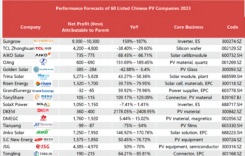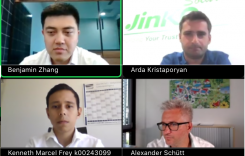PVTIME – On May 18, the Smart Empowerment 2020 PV Technology Conference organized and hosted by JA Solar was broadcasted via the internet due to the Coronavirus epidemic. JA Solar highlighted that 2020 is very special year for the company and the global PV industry as a whole. In celebration of its 15-year anniversary, JA Solar invited a list of renowned industry professionals, experts, and enterprises to discuss the opportunities, challenges, and emerging technologies of the industry going forward.
Since its establishment in 2005, JA Solar has since become one of the world’s leading photovoltaic companies covering the entire industrial chain. With a presence in more than 120 countries and regions, JA Solar’s products are widely used in ground-mounted photovoltaic power plants as well as industrial, commercial, and residential photovoltaic systems. Under the leadership of Chairman Jin Baofang, JA Solar aims to “develop solar energy for the benefit of all mankind”, and strives to realize its vision of becoming a grand company.
Special guest host, First Director and Director of Academic Committee of National Center for Climate Change Strategy and International Cooperation (NCSC), Li Junfeng, kicked off the conference by providing a special opening address discussing several challenges facing the development of the global PV industry. Mr. Li talked about the far reaching economic disruption brought on about by the Coronavirus epidemic which has been ongoing for the past 5 months. Due to rapid technical developments in recent years, production capacity of PV manufacturers has increased substantially while capacity expansion is on the agenda for many leading enterprises. However, prolonged global economic downtrend will upset global energy demand which will heavily impact the PV manufacturers and the industry as a whole. Specifically, if the current situation were to continue, while the industry as a whole will survive, many enterprises will not. Under these conditions, the industry has to put serious effort into developing strategies to overcome the challenges and maintain confidence in the development prospects of the “14th Five Year Plan”.
Wang Bohua, Secretary General and Vice Chairman of China Photovoltaic Industry Association (CPIA), delivered a presentation which analyzed the status quo and future prospects of the PV industry. He pointed out that in the past two years, despite the consecutive decline in newly added domestic capacity, the concentration of PV manufacturing operations in China increased, helping China maintain its position as the world’s largest PV market. Mr. Wang expects 110-135GW in newly installed capacity to be added worldwide in 2020, of which 32-45GW will be in China. Judging by the number of applications for grid parity projects, with a higher concentration coming from the leading enterprises, this year’s scale is likely to increase by 50% year-on-year. This will further the increase the concentration of all links of the industry, making the market more mature and stable.

Dr. Huang Xinming, Director and Senior VP of JA Solar, believes that the large-scale adoption of photovoltaics has been due to the decline in cost electricity, backed by the injection of huge investments and the unremitting research and development efforts of numerous PV enterprises such as JA Solar. “I hope you will continue to support the development of JA Solar and renewable energy projects on a global scale. In the future, JA Solar will stay committed to our manufacturing principles of being an efficient provider high quality products, stay true to our core values, continue to innovate, and contribute to the advancement sustainable clean energy development to the best of our ability.” Dr. Huang commented.
Professor Martin Green, dubbed as “the father of solar energy” by many, also made a special appearance during the broadcast. During his segment, he talked about the long history between JA Solar and the University of South Wales, and recalled his students’ participation in the creation of two Australian companies which went on to become the foundation for what JA Solar is today. The PERC technology invented by Martin Green has become the most widely used high-efficiency cell technology of the industry and JA Solar.
With various advanced technologies emerging one after another, what is the most suitable path of development for enterprises looking to expand production capacity? Corrine Lin, Chief Analyst of PVInfoLink, believes that although the epidemic has brought uncertainty to economic and industrial development, technological progress and capacity expansions have been unaffected. The recent emergence of 500W+ modules powered by 180-185mm silicon wafers have attracted the attention of the industry and the market. It is expected that within the next 2-3 years, there will be an influx of new mainstream wafer sizes in the market, and the current sizes will be gradually eliminated. In terms of applications, Ms. Lin mentioned that the global demand for modules is expected to decline to 108.8GW this year.
Tang Kun, Chief of JA Solar’s Product Technology Department, introduced JA Solar’s high-efficiency product line which includes the mass produced 450W+ high-efficiency modules and the new 525W+ ultra-high-efficiency DeepBlue 3.0 modules. He emphasized that large silicon wafers can effectively increase the power output of solar modules, which is an effective way to reduce the cost per watt. After extensive consideration and comprehensive comparisons, JA Solar believes that the 6×12 cell module using 180mm half cut, silicon wafers is the best starting point for ultra-high-efficiency modules. Tang Kun said that at this stage, the 210mm module is not as good as the 180mm module in achieving the highest power output, and its cost per watt is not significantly different from that of the 180mm modules. Therefore, modules using 180mm wafers offers better cost to performance.
The cost per kilowatt hour reductions advantages of high power output modules are best demonstrated when applied in PV systems. In this regard, Hui Xing, Director of Power China Northwest Engineering Corporation, said that high power output modules are well suited for flat terrains, are conducive to the intensification of land, and reduces construction costs and O&M costs down the road. She revealed that, in the report “Photovoltaic Power System Performance Specification” coedited by Northwest Engineering Corporation, there are clear requirements for installation capacity per unit area, on grid power connection, and power generation revenue. Application of high-efficiency modules allows enterprises to complete the corresponding assessments easier and also leads to greater returns.
Following the individual presentations, a panel discussion focused on how to occupy market share in a complex and evolving market took place. The panel participants consisted of Zhang Xiaochao from Huaneng Group’s New Energy Department; XU Bofeng from TBEA; Hui Xing from Power China Northwest Engineering Corporation; Xu Hailiang from TÜV SÜD; and Li Dong and Tang Kun from JA Solar.

Li Dong expressed that, although the world is still affected by the Coronavirus, he remains optimistic about the future of the photovoltaic market. He believes that the installed capacity in the fourth quarter of this year will make up for the delayed market demand in the first three quarters. The overall development for the year will be stable and the newly added capacity for the year will be about the same as last, 100-110GW. To a certain extent, the epidemic has helped in increasing the manufacturing concentration of the industry, eliminating inferior production lines, and the smooth transition into the new era of grid parity.
Xu Bofeng believes that from April onwards, the domestic photovoltaic industry will be well on its way to recovery, but global recovery will not happen until 2021. The PV industry needs to use this period to increase research and development efforts, reduce costs, increase efficiency, unify upstream and downstream operations of the supply chain, solve consumption constraints, reduce non-technical costs, and lead the high quality development of the PV industry.
Xu Hailiang proposed that before new products are launched, third party testing and certification work should be completed in order to obtain the relevant certifications. According to observations, the consumers are often concentrated on the reliability and safety of the products. He recommended that enterprises should carry out research and development and outdoor demonstrations at the same time to reduce the possibility of hiccups.
Zhang Xiaochao said that high power output modules have an important role in reducing the cost of electricity and improving a project’s profitability, which can effectively attract more investments and accelerate industry development. Achieving grid parity is not our ultimate goal. In the future, solar energy will play a key part in the global energy market reform and provide crucial support to smooth the transition.
The panel and the cloud conference came to a conclusion when each of the guests extended their congratulations to JA Solar on their 15th anniversary. In just 15 years, JA Solar has grown into a world-class provider of PV power generation solutions, and is widely recognized by the PV industry and its customers from around the globe. Moving forward, JA Solar will continue to focus on technological innovation, provide consumers with high quality PV products, and promote the development and utilization of clean energy on a global scale.











